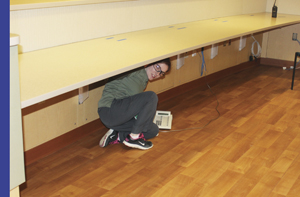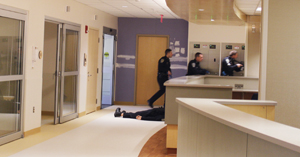By BETSY TAYLOR
St. Joseph Hospital in Nashua, N.H., recently teamed up with the local police department to conduct an active shooter drill in its new emergency department before the unit opened to the public.
In holding the drill, administrators at St. Joseph Hospital acknowledge that emergency rooms, where sick, scared and traumatized patients come to be healed, also can be volatile environments. Gang vendettas may follow a shooting victim into a hospital. Patients or visitors may be agitated, mentally ill, aggressively drug seeking, or stressed by illness or crises beyond their personal breaking points. Although shootings are extremely rare in U.S. health care facilities, the National Center for Victims
of Crime reports that work-related assaults are not. Ministry hospitals are giving staff training to recognize a potential threat and protect themselves and patients by de-escalating a conflict, when possible, or getting out of harm's way and calling in reinforcements.
Shots fired
In the St. Joseph Hospital drill on March 26, a Nashua police officer portrayed a drug-seeking patient, who, enraged at being denied narcotics, "shot" three people in the ER and holed up in a supply closet with two "hostages."

During a recent active shooter drill, a St. Joseph Hospital staffer in Nashua, N.H., shelters in place by crouching under a counter with a phone to summon help.
Even knowing it's a drill, the images are hard to take in: a hospital staffer "sheltering in place" crouched under a counter with a phone to summon help; Nashua police officers, weapons drawn, hurrying past a body on the floor — actually a student portraying a shooting victim — as they track the "shooter."
In the six months leading up to the drill, staff in every hospital department watched the training video "Shots Fired for Healthcare: Guidance for Surviving an Active Shooter Situation in the Healthcare Community" produced by the Center for Personal Protection & Safety, a security training firm. They reviewed emergency codes and the procedures for having the codes sound over a public address system. During the drill, staff assisted "patients and visitors" to secure locations, away from the violence. But some staff had to shelter in place and restrain their instincts to rush to the aid of the injured while the assailant was at large. Dupuis said that step was hard for health care providers participating in the drill. Many found it difficult to lock doors or hide under desks knowing there were people who needed medical attention.
Although the drill was staged in the ER, hospital staff from every unit participated. Police and security officers, observers from other hospitals and community volunteers, all filled out evaluations, and their observations will be incorporated in an after-action report and security response improvement plan, Dupuis explained. One early learning was the importance of clear communication before, during and after an event, she said.

Nashua police officers hurry past a student portraying a shooting victim in an active shooter drill in March at St. Joseph Hospital in Nashua, as they pursue another officer who plays the assailant during the exercise.
In an article published in the Annals of Emergency Medicine in 2012, researchers at Johns Hopkins University School of Medicine in Baltimore analyzed reports of 154 shootings at acute care hospitals between 2000 and 2011, which resulted in 235 dead or injured. They found shootings at hospitals to be infrequent, but difficult to prevent because most involved a determined shooter. Most perpetrators had a personal association with victims.
In harm's way
Violence in health care settings has long been a concern for the Emergency Nurses Association, a Des Plaines, Ill.-based organization. In its Emergency Department Violence Surveillance Study, which surveyed 7,100 emergency nurses over several months and was issued in 2011, about 12 percent of participants reported that they experienced physical violence and 42.5 percent reported verbal abuse during the seven days prior to taking the survey. The majority of those who experienced violence in their workplace did not file a formal report with their employer about the event.
Nurses working in facilities with zero-tolerance of violence policies and with administrators and managers committed to less violence in the workplace reported they were less likely to experience physical violence and verbal abuse.
Zero-tolerance for workplace violence policies may vary in their specifics, but usually say an employer won't tolerate offensive or threatening language, aggression or assault directed toward hospital staff members by patients, visitors or other staff members. They call for emergency department staff to report all verbal or physical violence. They ban patients and visitors from having weapons and other items that could cause harm, such as pepper spray.
Many policies state violations will result in immediate security action, including the potential for the perpetrator's arrest. JoAnn Lazarus, a board member and immediate past president of the Emergency Nurses Association, worked about 30 years in ER nursing before becoming a health care consultant. She said nurses, hospital administrators and other staff may be tolerant of verbal or physical abuse because they are cognizant of the patient's stress level, but it is not an acceptable part of the job. "I don't think we've taken the whole ownership to say: You know what? It is not part of what we should be having to work with. We should be able to be safe."
Calling a code
With de-escalation as an intervention goal, St. Louis-based SSM Health Care is using BERT teams — short for behavioral emergency response team — at four of its hospitals with behavioral health units. It plans to form teams at other hospitals as well, said Gayle Reneer, SSM Behavioral Health's vice president for nursing/patient care services. Each team is made up of in-house behavioral health and security specialists who are summoned when a hospital staffer determines a patient is verbally abusive or showing signs such as rapid breathing or pacing that often are precursory to physical aggression.
When the BERT team code is called, the three to five people on each team head for the vicinity of potential trouble, but they are careful not to overwhelm the patient and escalate the situation. "They're not all going to go running into the room," said Reneer. "The reason all those folks respond is not because we need all of their expertise in the moment. It's because we need to be able to accommodate many different scenarios or situations."
If a patient is agitated or upset, a behavioral health specialist will lead the intervention attempting to verbally calm the individual, and may offer a sedative. In extreme cases, a patient may be placed in restraints.
If a patient attempts to hit, kick, spit at or bite a staff member, a "Code Strong" is called for instead of a BERT response. That signals security staff to take the leadership role.
Reneer witnessed a BERT team in action last summer when a behavioral health patient who said he was contemplating suicide was brought into an ER by a worried friend. As the patient became upset, his treating doctor and nurse paged the BERT team and then stepped out of the room to brief the responders about the patient's situation.
A BERT team behavioral health nurse entered the patient's room alone and sat down at his bedside to ask him about the reason for his outburst. The nurse gained the patient's trust and he accepted medication, which enabled him to relax and regain composure. "Our goal and our focus is safety for both staff and patient," Reneer said.
Safety in numbers
Emergency department staff at Trinitas Regional Medical Center in Elizabeth, N.J., wear name badges that emit infrared light and radio frequency signals. The technology is made by Versus, a company based in Traverse City, Mich.
Denise Loneker, nurse manager of the emergency department, said when a staff member pushes a button on the badge it sends an electronic alert, with the employee's name and location, to the computers of three staff members. One of those people immediately responds to the location of the page and determines if there's a need for immediate medical or security support.
Loneker said emergency management services personnel and police often communicate before a patient comes into the emergency department. Aggressive patients are brought in with a police officer or officers who maintain a presence until the patient is no longer a security concern. She said experienced charge nurses who first assess ER patients can put a patient "on watch" if the individual is aggressive, hyper-agitated, or at risk of self-harm, for instance. A technician trained in de-escalation strategies sits with the patient, watching for behavioral changes and summoning assistance when needed.
Loneker said that while staff know to be vigilant in the presence of behavioral health patients in an acute crisis, other patients can show unexpected and aggressive behaviors too. She said elderly patients and patients with dementia can become anxious or aggressive when they have infections. Dehydration can cause behavioral and emotional changes. Grief can cause family members to lash out at staff. But alert staff, who have training in de-escalation techniques and know to summon additional support, often are able to gain control of the situation and quickly act to make a patient feel better, she said.
Additional resources:
The U.S. Department of Labor's Occupational Safety and Health Administration provides resources related to workplace safety in hospitals and the Emergency Nurses Association offers an online toolkit about ways to protect against workplace violence.
St. Joseph Hospital communicates with several audiences about active shooter drill
At St. Joseph Hospital in Nashua, N.H., a key step before, during and after an active shooter drill in March was making sure that patients and the public understood the hospital was conducting a drill, and not experiencing a true emergency.
Sheila Caron, marketing/media specialist at St. Joseph Hospital, explained how the hospital notified different audiences about the drill.
Before the drill, St. Joseph put out a news release, posted messages on its Facebook page, placed notifications for patients in the hospital on their meal trays and put out large yellow signs explaining that a training drill was to take place. The new emergency department where the drill was staged had not yet opened to patients; hospital care proceeded as normal during the drill, including emergency care in the temporary emergency department. Following the drill, an "all clear" was sounded over the address system, and the hospital's Facebook page was updated with the news the drill was complete.
Copyright © 2014 by the Catholic Health Association
of the United States
For reprint permission, contact Betty Crosby
or call (314) 253-3477.